It is sad that the history of this family was not written, at least, a generation earlier - perhaps two. Such a comment would be applicable to most families, but it applies to this family in particular for there has been a name change - apparently - the need for which we have not yet been able to understand. This phase of the discussion will be considered later in the chapter.
At the conclusion of the last chapter , we were yet considering the John Blacker family, which had moved to Monmouthshire before 1849, in which year their first 'Welsh' child was born. We followed them as best the information of them will permit, to the wedding of Edward and Althera Loveday. Prior to our story of the Loveday family we may find a family-tree chart helpful.
- Solomon Lowther (chr 8 January 1792)
- Spouse: Mary Gooding
- George
- Fanny
- Isaac Loveday (1821) = Mary Danks (1832)
- Hyrum (1850) = Margaret Jenkins
- Althera (1852) = Edward Blacker [Note the joining of the Blacker-Loveday lines at this point.]
- Kemuel (1855) = Mrs. Owens
- Fannie (1858) = Thomas Lewis
- Thomas (1859-died unmarried)
- Isaac (1862) = Emiline Maloney
- Sarah Ann (1865)
- Solomon
- Mary
- Spouse: Rachel Tuck
- John
- Hannah
- William
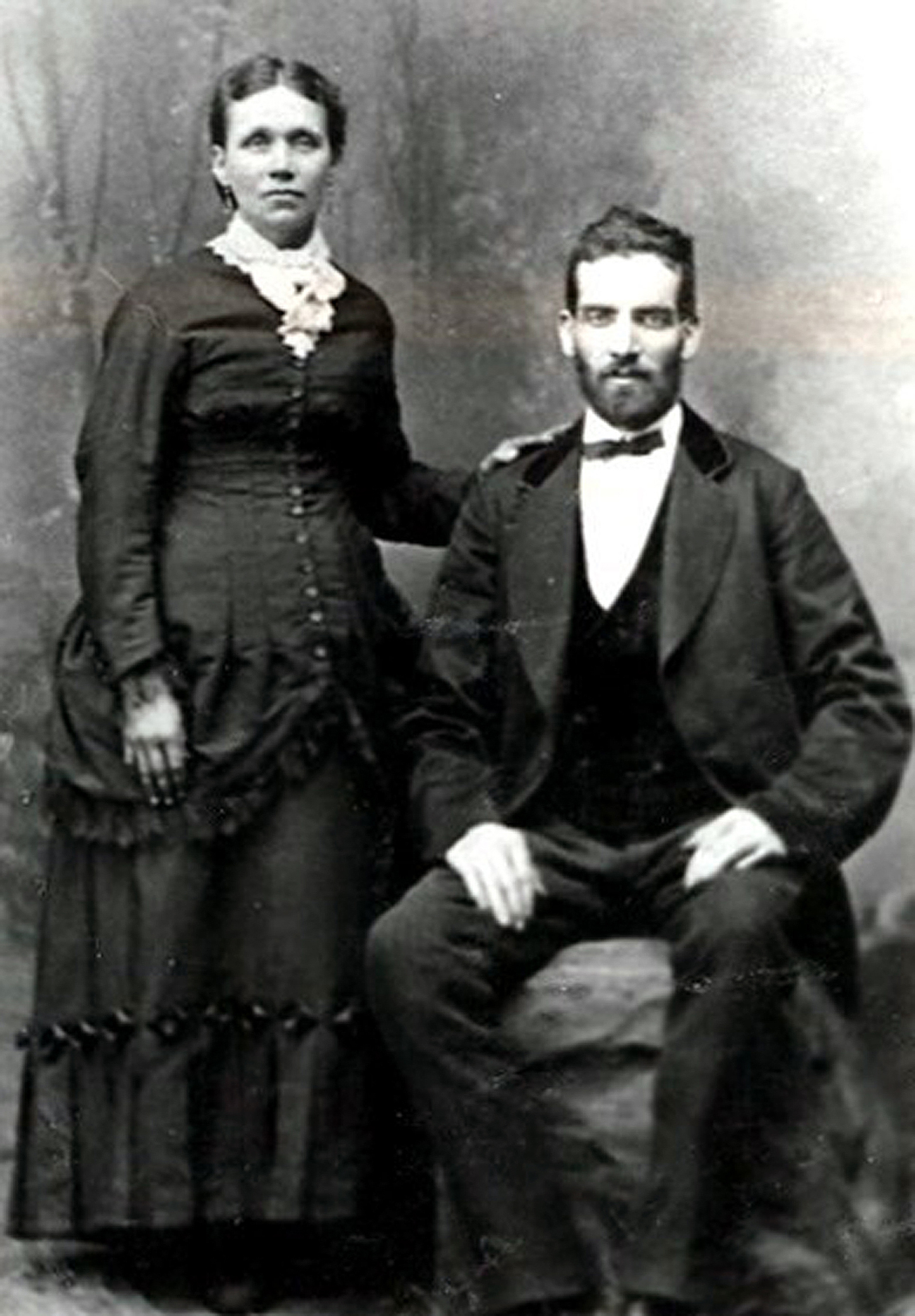 Althera Loveday and Edward Blacker
Althera Loveday and Edward Blacker
Althera Loveday was born, as can be seen from the chart, to Isaac Loveday and Mary Danks in Pontypool, Monmouthshire, being the second child of the family. All evidence points to this family remaining in Pontypool until after the death of their last baby on the first of July 1866. This would indicate that, at earliest, Althera would have been probably thirteen to fourteen years of age when the family moved to Mountain Ash across the county line into Glamorganshire in South Wales. Her marriage date to Edward Blacker is the 27th of October 1873, therefore, she was well over 21 years of age at the time of their marriage.
According to a copy of their marriage certificate they were married by banns, meaning that their respective names were read in their respective parishes for three Sundays, previous to the marriage, with no one objecting. How Althera obtained her banns is left to our imagination. We failed to inquire while she was still alive. The copy of the marriage certificate was not requested from London until 1965. When I was visiting with Uncle William in 1930 - thirty-five years earlier - and he was showing me the chapel in which they were married, I actually knew little, if anything, of the use for banns, therefore, too naive to make inquiry. From the marriage certificate, we confirmed the marriage date, and the age she gave as a spinster agreed with her birth record of the family.
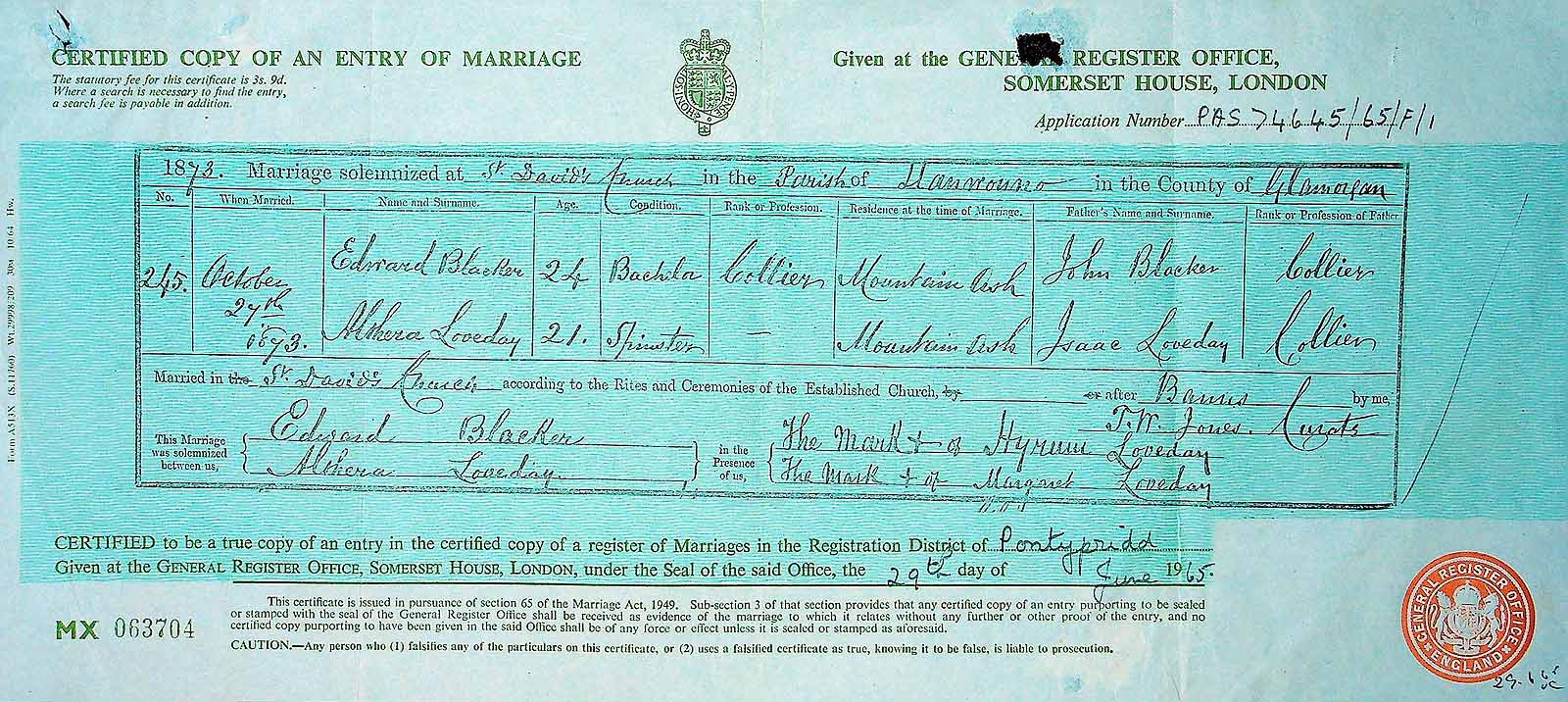

However, Edward didn't seem to fare so well. It has been explained on page 48 of this story, but neither of the two dates credited him agrees with the marriage certificate. On it he is recorded as being twenty-four, and a bachelor at the time, actually two years older than he really was. The registrar could have misunderstood or it may be possible that his efforts in finding a wife and preparing for the ceremony could have made an old man out of him.
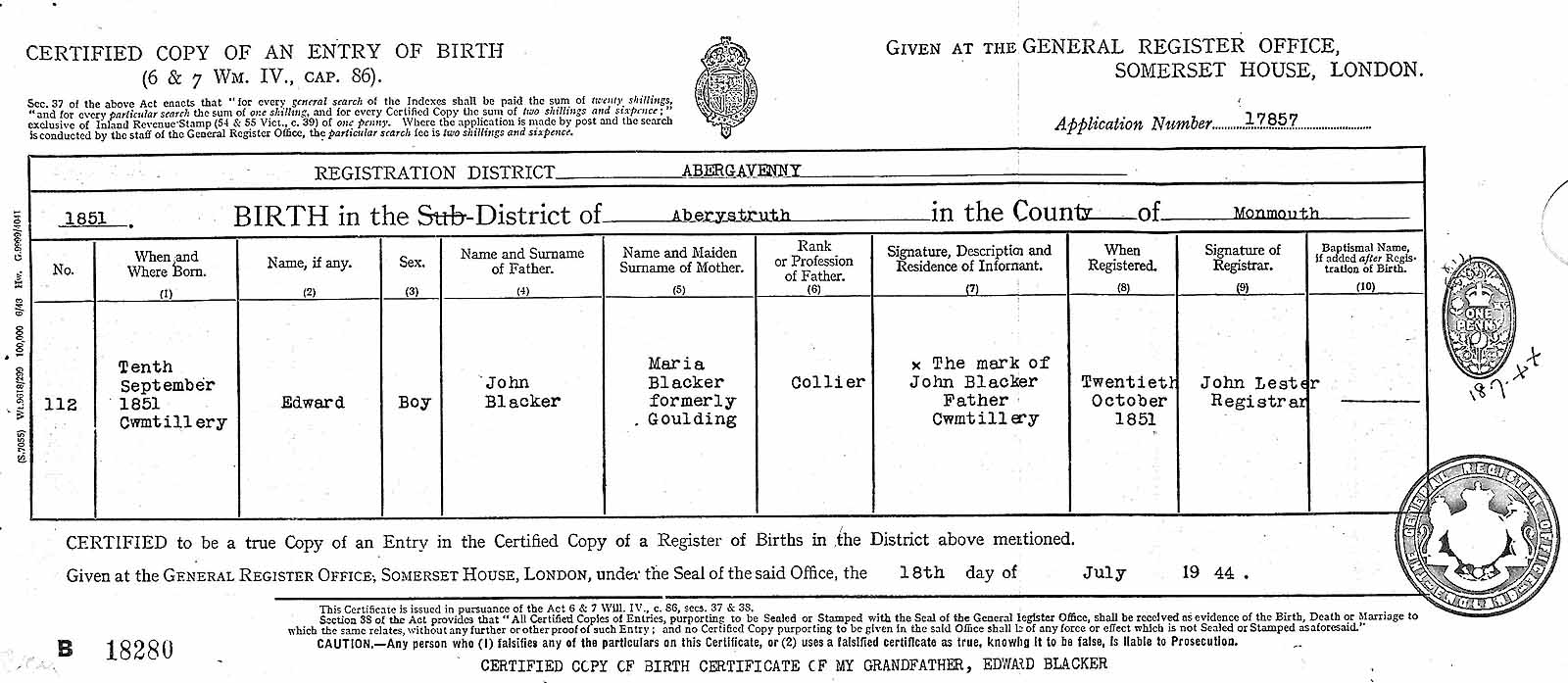
On the 20th of October 1851, John Blacker of Cwmtillery in the sub-district of Aberystruth, in the registration district of Abergavenny, walked into the registration office and reported the fact that a month and ten days earlier, a son had arrived at their home on the 10th of September 1851, and that they had given him the name of Edward. Prior to the 18th of July 1944, when this certified copy was made out, the family records had shown Grandpa Edward’s birth date to have been the 15th of June 1850. While errors sometimes appear on copies of birth certificates, they usually have preference for accuracy over family records.
Click here to see a map showing Cwmtillery
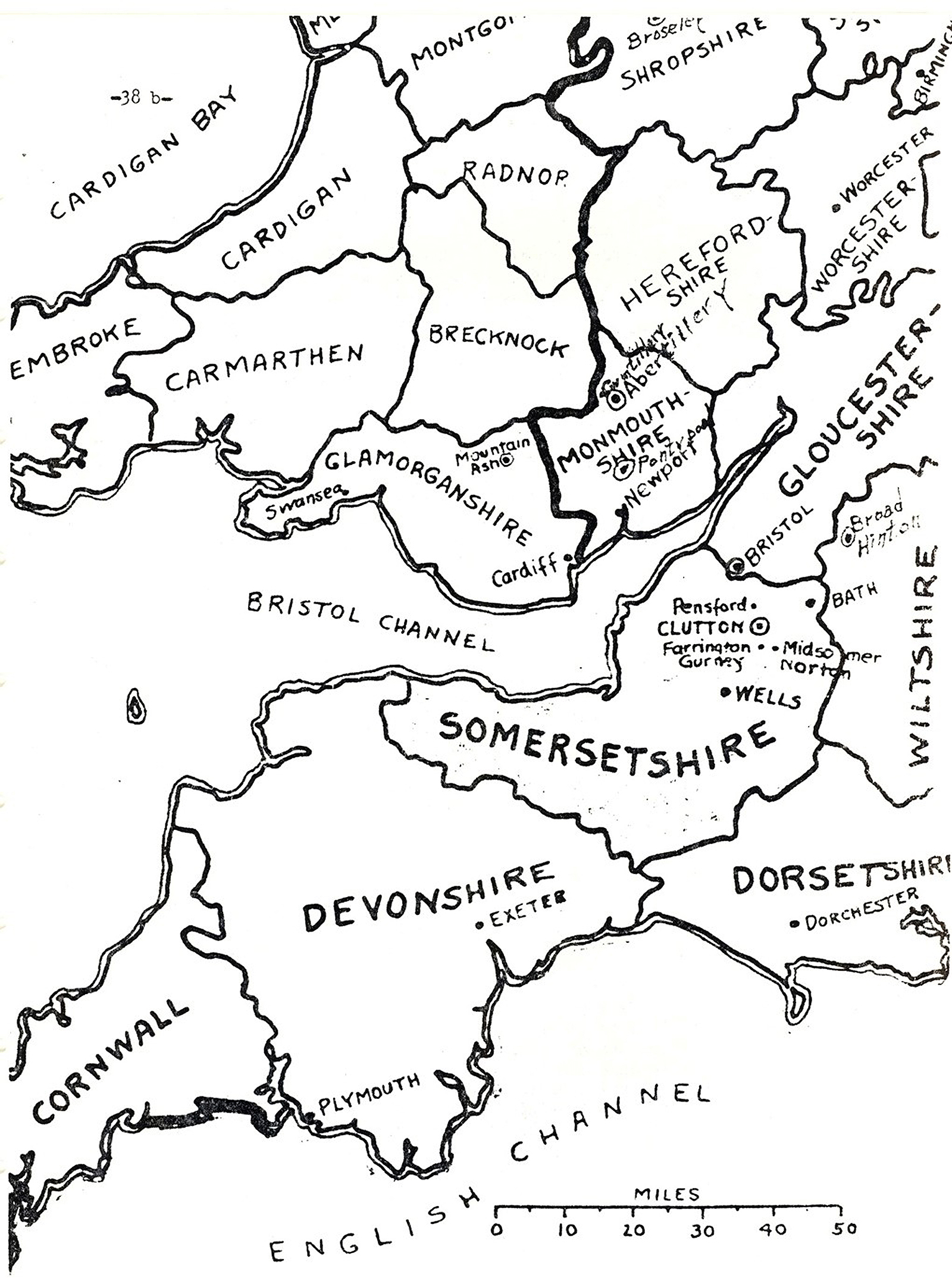
There was no indication from the certificate that Althera nor Edward were unable to write, but the signatures of both witnesses, Hyrum, Althera's older brother and his wife, Margaret, were written in following their mark (X), indicating they could not sign personally.
Now to Althera's family background: the family record of her father, Isaac, shows him to have been born in Broad Hinton, in Wiltshire, the county joining Somerset to the east. This is the same county which we discussed as a possibility of the Blackers originating prior to going to Clutton. Broad Hinton was a small rural town with a population of fewer than a thousand people. Actually, measuring across the map it is approximately thirty-five miles east and somewhat to the north of Clutton. When Isaac was born at that place, his far future son-in-law's father, one John Blacker, was just a boy of about three to four years of age over in Clutton. There seems hardly a possibility that the Lovedays and Blackers knew each other but, for the sake of a story their closeness of family origins is mentioned. See map showing Broad Hinton, Wilts., on the right.
Actually, when Isaac first shows up in our family history, it is after he had arrived in Pontypool, Monmouthshire just a few miles from where John Blacker had taken his family from Clutton back in about 1849 or perhaps a year or two earlier. This then, becomes about the same time both Blackers and Lovedays move to Monmouthshire, but of course, in different towns.
How long Isaac had been in Pontypool before he married we have no way of knowing, but his marriage to Mary Danks, also of Pontypool, took place on the 5th of August 1849 which brings us to another interesting story, but a full generation before. Let us put our story of Isaac on 'the back burner' until we review this previous story. We shall be back to him and tie the two stories together and thence into the third story; that of Althera and Edward Blacker, on which we already have started.
Mary Danks, whom we have just mentioned as the new wife of Isaac Loveday, was the second daughter of Peter Danks and Ann Powell. Marriage is always an interesting event and what is more interesting is how and why two people appear to get together, particularly so when they come from afar such as Edward Blacker in Mountain Ash and Althera Loveday in Pontypool, Also, of Isaac Loveday in Broad Hinton and Mary Danks in Pontypool, and now of Peter Danks from far away Broseley, Shropshire (about 70 miles away from Pontypool )to that place to find his wife, Ann Powell.
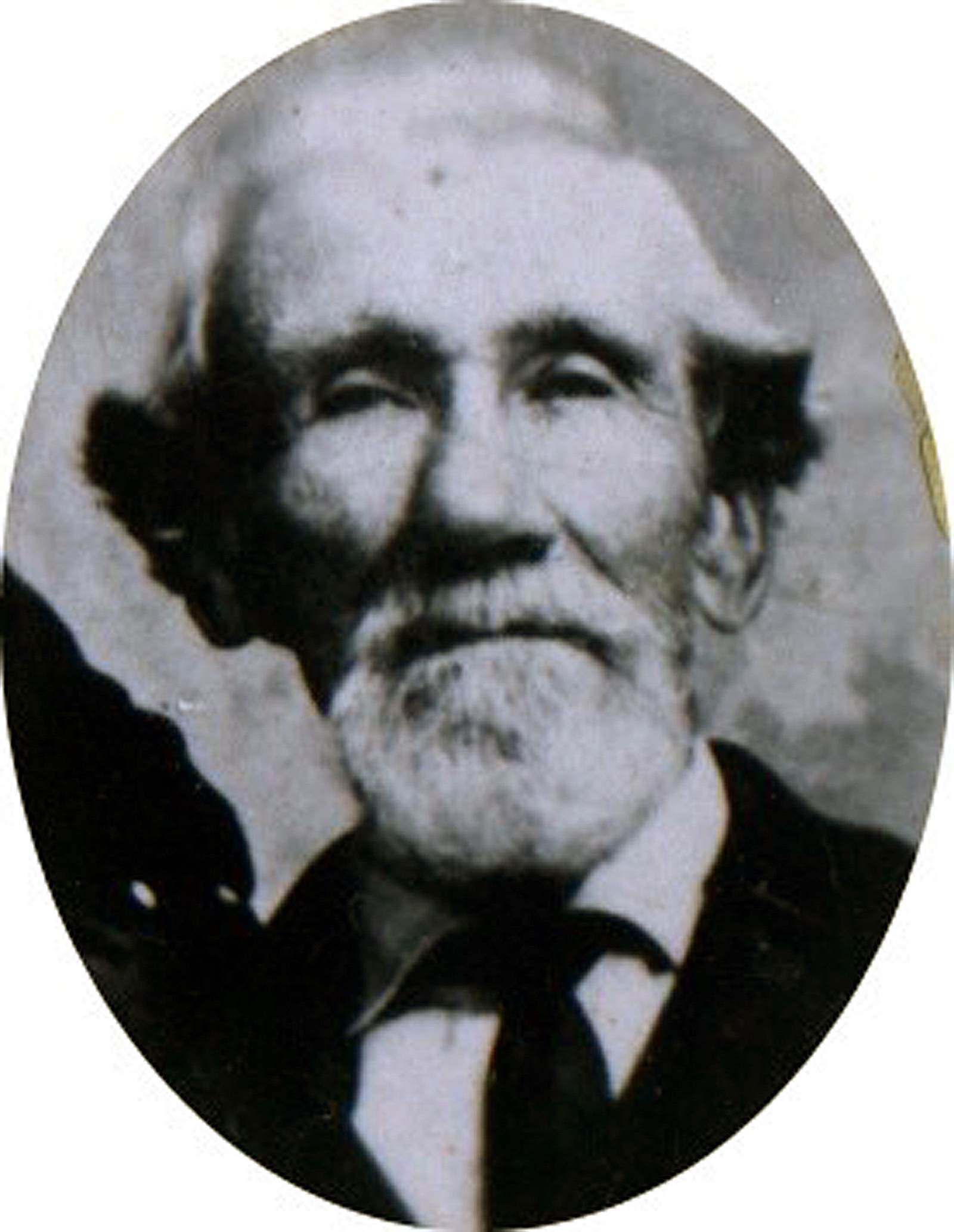
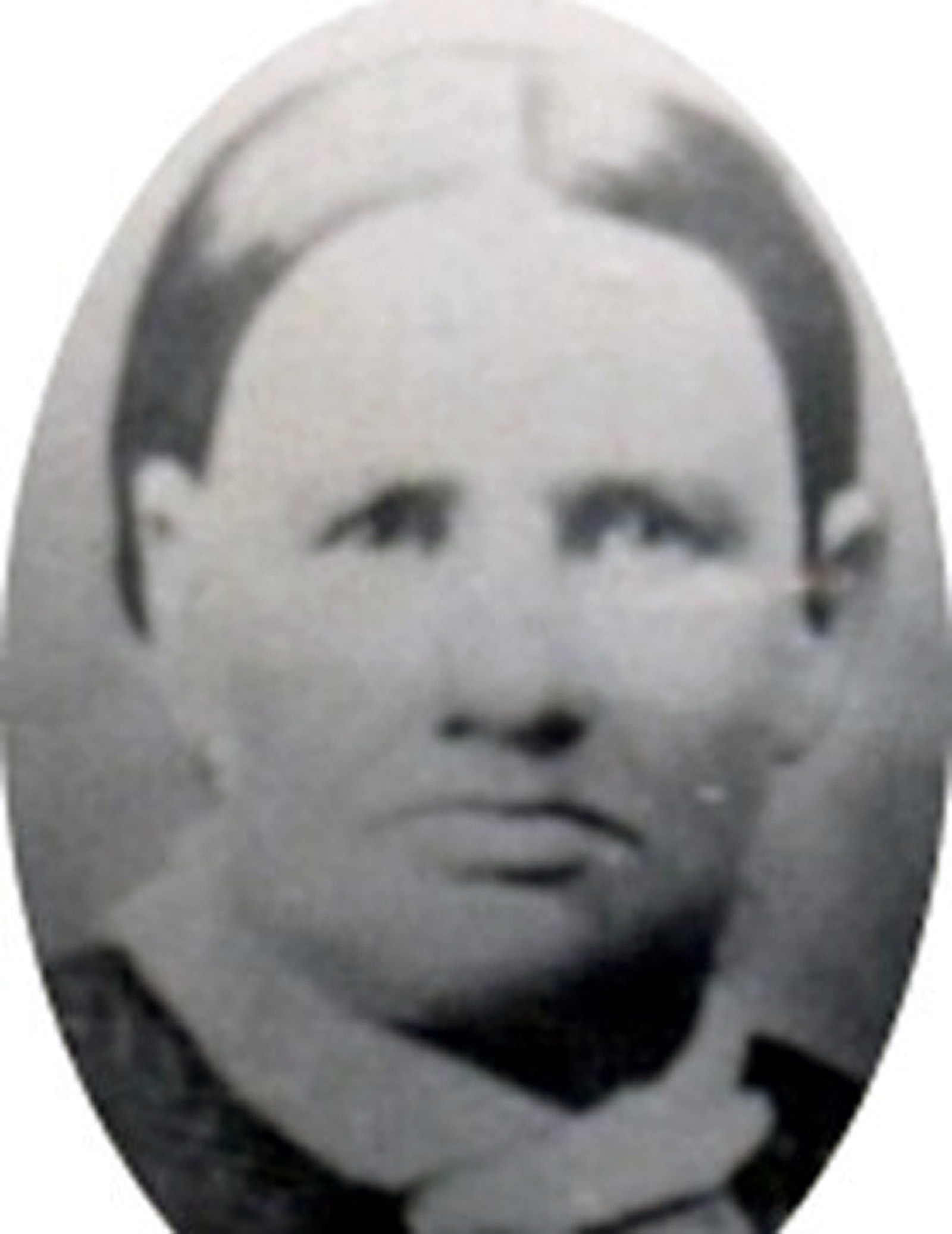
It is interesting to speculate what line of work might have brought Isaac to Pontypool in the first place. We have no way of knowing just when he left Broad Hinton. From a much later account of his, which we shall eventually relate in this story, Isaac claims he had always been an agriculturist, This included his being a farm laborer for others as, also, farming for himself. Perhaps as a boy and a young man he could easily have been employed by neighboring farmers, for his birth place town, Broad Hinton, was certainly in a rural area in his day as it has remained to quite an extent. Isaac's father, Solomon was listed as a farmer, so we turn to the old cliche, "like father like son."
Could there be a connection in the following information? In a gazetteer of England, Pontypool is listed as a market town. A market place in any market town was, a century ago or even half a century ago when I spent two years in the British Isles, filled with horse-drawn carts or even two wheeled man-pushed carts. These contained farm raised vegetables or small animals, such as chicken, rabbits, piglets, sheep. There were also, "on the hoof", ready for butchering, larger animals, all from nearby farms and some from a few miles away.
These market days - usually once a week, sometimes twice - represented a great amount of work done out on the farms from whence the produce or animals came. Large amounts time was spent in preparation by farmers or farmers' helpers. If Isaac, Loveday, down in Wiltshire, as a young man, was seeking to better his employment conditions, who knows but that by some means he heard of this market town in Monmouthshire, mustered up courage, threw his shoulders back and said, "This is it, I'm going!"
At this very period of time, particularly thru the decade of the 1840s, a movement - a social movement with a religious vein - was taking place in England. For two decades - the 30s and 40s - it had affected America. Now it had arrived in the western European countries, particularly in Great Britain, and young Isaac was to become affected by it after he reached Monmouthsire. Just a word by way of background of this social phenomenon - this religious revolution, which, in very deed, it was.
In 1830, a new church was established in America, The Church of Jesus Christ of Latter-day Saints, which later became known as the Mormon Church. This second name came from the fact that Joseph Smith had translated a sacred record kept by the prophets of the forefathers of the American Indians when that people had lived for over a thousand years in pre-American from 600 years B.C. to down past 400 years A.D. This translated record came to be known as The Book of Mormon, hence the nickname. These ancient peoples' prophets had eventually been slain thru the wickedness of a branch of the people. Just prior to the last prophet's final words, he was instructed to bury his sacred record in a hill which he did to finally come forth in 1827 in the western part of the state of New York.
Prior to this event, the young man, Joseph Smith, while praying to inquire as to which of the many churches was right for him to join, received an answer at which time two Heavenly Beings appeared before him - God the Father and his Son, Jesus Christ - and told him not to join any church for they were all wrong but to wait for a period of time when authority would be given him to organize a restored Church.
This, indeed, was a revolutionary message, but the event had been promised by the scriptures. However, the ministers would have none of it. Just as the Savior and his apostles drew severe criticism when the Savior organized his church in New Testament times and were slain because the people at large would have none of it, so with the restoration in this day. Satan set into the hearts of men to have nothing to do with the new Church. Instead, when they had been at odds with each other over their religious teachings, they joined together in a joint effort to hinder the progress of the Lord's new Church - the same Church, but restored. Joseph Smith, in 1844 was killed in cold blood, along with others, because he would not deny that he had seen a vision, which he knew he had and which he knew that God knew that he had, and he dared not deny it.
Without going into further details at this point, let it suffice that the Lord had instructed this new prophet and his new apostles to whom proper authority had been given, to take the message of the Restoration to all the world.
In 1837, missionaries entered Great Britain to share this message. At first, phenomenal success was had and within the first very few years thousands upon thousands eagerly listened and were touched to join the new Church. In England as in America, ministers of the gospel of all denominations saw what it was doing to their livelihood - their churches were losing members. They were teaching for hire - the new Church expected its lay-members to spread the message without monetary recompense. After their conversions, the new members were told to go to America to strengthen the new Church there. This became the goal of new converts and throughout the decade of the 1840s, thousands of British people filled boat load after boat load to commence their journey to Zion, as they termed the headquarters of the new Church.
Wales, the new home of the Blackers and now also of Isaac Loveday, was more or less to the side of the mainstream of the greater masses of people, but Wales was not being forgotten by the missionaries from America. Actually there was some proselyting in Wales as early as 1840 and this included Monmouthshire. A small branch of the new Church was organized in Penydarren, a village near Merthyr Tydfil in Glamorganshire as early as March 25, 1843, which area is but fifteen to twenty miles north and west of Pontypool.
One of the most noted Mormon missionaries, who made Merthyr Tydfil his headquarters within the first few years, was a small Welshman who had previously emigrated to America. He became acquainted with the Prophet Joseph Smith. His name was Dan Jones, and he willingly went to jail with the Prophet in Carthage when, just the night before the Prophet was martyred, he, the prophet, in the quiet of the night told Dan Jones that he would live to return to Wales. Using the Prophet's own words, "You will yet see Wales, and fulfill the mission appointed you before you die." (See Vol. 6, History of the Church, p. 601)
In 1846, at a Church conference for all of Britain which was held in Manchester, Dan Jones reported that at that time the Welsh District, over which he presided, consisted of 28 branches and 687 members, of which 378 new members had been baptized since the last conference. This, probably, was within six months - certainly not over a year. Jones, who could speak the Welsh language fluently, as well as English, had written six different pamphlets which had been given wide circulation both in explaining the Restoration and defending the Church against many false accusations. Considerable persecution was being heaped upon those who joined the Mormon Church and the national press was being used quite extensively in vilifying all that pertained to the Church. It was fast becoming the thing not to do, but the Lord's work was not to be stopped.
By the 11th of December 1848, Isaac Loveday had been converted and was baptized a member of the Mormon Church. A branch of the Church had previously been organized in Pontypool and it was in the meetings of this branch that, undoubtedly he had attended, where he was taught and encouraged by both missionaries and local members. Isaac by now, had just recently passed his 27th birthday and was still single. What schooling he had in his younger years we don't know, but he was always known to have had an inquiring mind and, long after his death, his grandchildren recalled his much reading, particularly of the scriptures.
It appears the much criticism and even persecution of the Mormons did not deter him from casting his lot with them, for he knew it was the truth they represented. We do not know how many months he attended Mormon meetings before his baptism. Most often such events take longer to transpire than overnight, so to speak. We do know the branch in Pontypool, as elsewhere, was growing and that Isaac was not the only recently baptized convert in the branch.
Among the other members - and relatively recent converts - was a family by the name of Danks. Peter Danks, a coalminer, with his wife and seven children, regularly attended the meetings of the branch. The Danks' had previously lost one of their little boys - three years previously - but the children then ranged in ages from Caroline, age twenty-one, down to little Peter, just two.
- Caroline (1827) = John Matthews
- Mary (1832) = Isaac Loveday
- Henry (1834) = Rachel Jenkins
- Sarah (1836) = Mr. Williams
- Peter (1838-died as a child)
- Thomas (1839) = Sarah Ann Beynon
- Jane (1843) = Samuel Thomas
- Peter (1846) = Louise
In looking over the record of the Pontypool branch, now, 134 years later, we find that the mother, Ann Danks, had seen fit to be the first of the family to join the new Church. She had been baptized a full year prior to Isaac's joining, but her husband, Peter, was not long behind her for he was baptized on the 8th of January of 1848, just a month following his wife. It is quite possible that their young son, Thomas, nine years of age was baptized the same time as his mother. He was likewise baptized in 1847, but the day and month are not shown. Some of the younger children had to wait until they reached their eighth birthday, for they were too young when their parents joined. Interestingly, eldest daughter, Caroline, was baptized a little over a week before she was twenty-one years of age and second daughter, Mary, aged sixteen at the time of which we are dealing with, was also baptized in 1848, but here again the record does not give the day nor month. See family chart on the left.
The reader who is acquainted with our family genealogy has, undoubtedly, already detected that the Danks family to which we are referring is as much an ancestral family as is the Loveday family, for less than a year following Isaac Loveday's and their second daughter, Mary Danks's baptisms, they were married. He by then was to be twenty eight within less than a month and she, seventeen on her next birthday.
This marriage became a very important event so far as we of the Edward Blacker family organization is concerned - in fact a vital date. Without it we would not have been who we are, but before we follow their history toward us any further, let us take a moment to trace Mary's family, the Danks', back a couple of generations.
Peter Danks, the father of the family we are discussing, was not a native of Pontypool; however, his wife, Ann Powell was born in Panteague, Monmouthshire near Pontypool. Peter was born two counties to the north, approximately seventy miles, at Broseley, Shropshire, as previously mentioned.
Here again we have the same question with Peter that we had with Isaac Loveday. Why, as a young man, did he leave his home and travel that distance, southward instead of north and west as did Isaac? Seventy miles is like going nearly half way across England. In that country it would require quite an impelling force to get a youngster to go that far from home. So far as any records we have found of him, he was always a coal-miner. We don't know the details of his move and could make a long story by just supposing such was the condition or something else was the reason. In all likelihood his moving such a distance while yet a young man who not the usual thing.
Peter was born in Broseley in 1801 and we have not been able to find his marriage record, but inasmuch as his to-be wife was a native of the Pontypool area, and the fact that their first child was born in Pontypool tells us that in all probability their marriage was also in or near to Pontypool. With his first child being born in 1827, it would appear quite probably that Peter was well of age when he married. His wife, Ann Powell, was some five years younger than he.
Peter's ancestral tree appears in the chart above
Ann Powell, the wife of Peter Danks, of whom we have been noting, was the second daughter in the family of twelve children of William Powell and Mary Morgan of Panteague, a small locality near Pontypool. Research has not extended this particular line beyond them, he being born in 1782 and she, by deducting from the 1851 census, in 1788. From this same census record, William Powell was reported to be a collier. Ten years earlier ,the 1841 census also so labeled him. The English professional researcher serving the Genealogical Society located the Baptist Chapel Registers, Trosnant, Pontypool, Trevethin, Monmouthshire England in Volume 50 a list of all twelve children of William Powell and Mary Morgan which, to say the least, is quite unusual, for research is not often so fortunate.
It is interesting to note this particular list shows the family to have lived at six different addresses during the period covered by the birth of the twelve children.
Back to the Peter Danks, Ann Powell Danks' family. In the Pontypool Branch record the statement is made that this couple "were cut off the Church for neglect of duty." This is interesting, but not overly alarming, for during this early period of the Church, there were instances where local church leaders overly felt the weight of their responsibility and became anxious - overly anxious - in seeing that all members conformed to the letter of the law. No attempt is being made here to justify such neglect of duty on the part of these good folk of our ancestry. It was in 1852 that this neglect occurred and we have found no official statement as to whether this was to have meant excommunication or disfellowship. Regardless, they undoubtedly were activated and returned to the Church.
It appears most, if not all, of the Peter Danks family emigrated to the United States. Whether they all came as a group, we don't know, but it seems more logical that they wouldn't, for several of the children were married in England and may have even started their families there. We have not researched this matter, but we are aware that Caroline married John Mathews (at one time he used Jones as his surname, but dropped it when coming to America.) We are aware that Thomas Danks, who married Sarah Ann Beynon, came to America and Jane Danks, who married Samuel Thomas, moved to Almy, Wyoming. Also, this is true of Peter Danks, who married Louise______. Certainly, Mary Danks, who married Isaac Loveday came to Wyoming and perhaps another one or two also left England or Wales as the case may have been at that time with Monmouthshire.
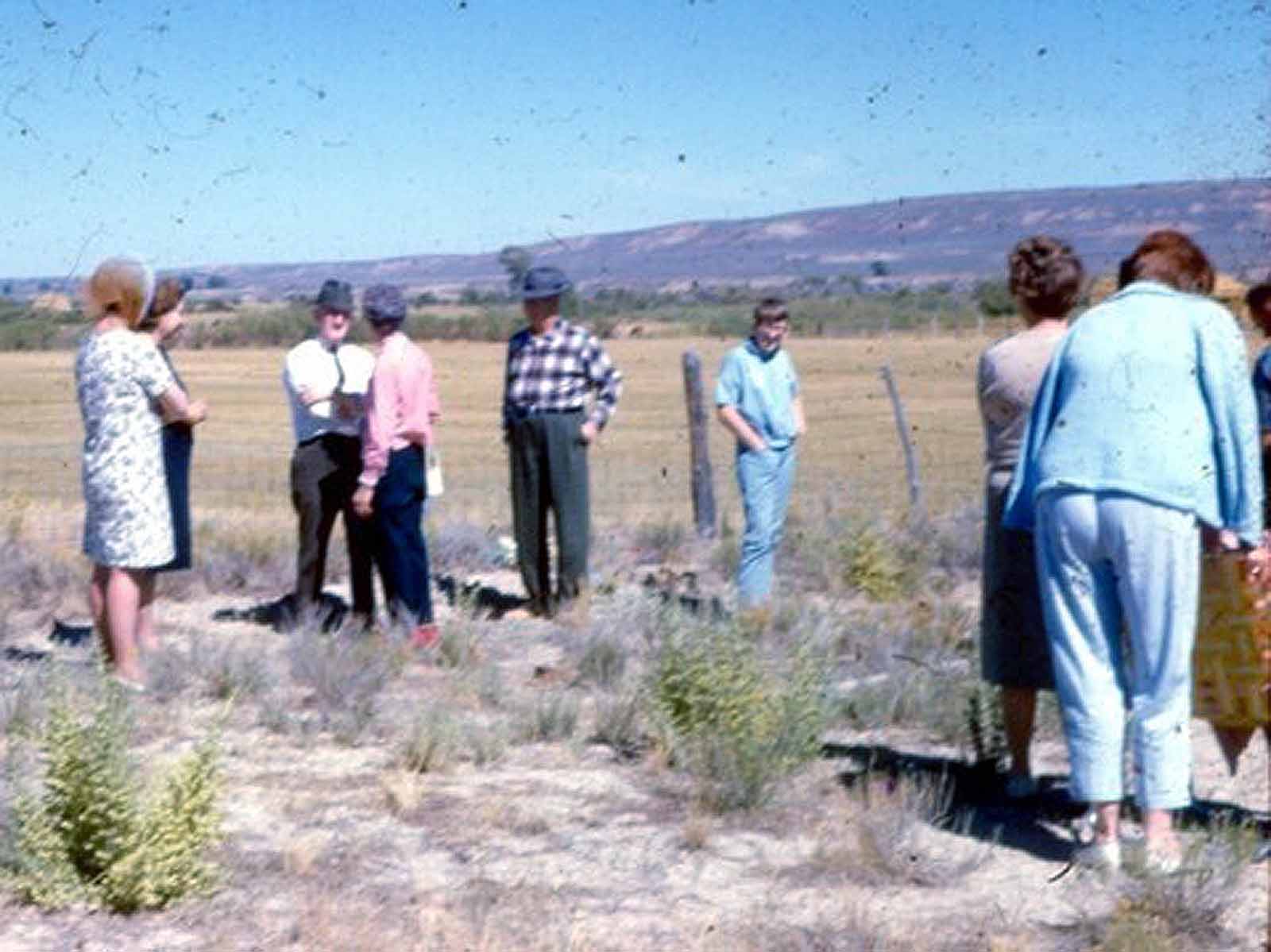
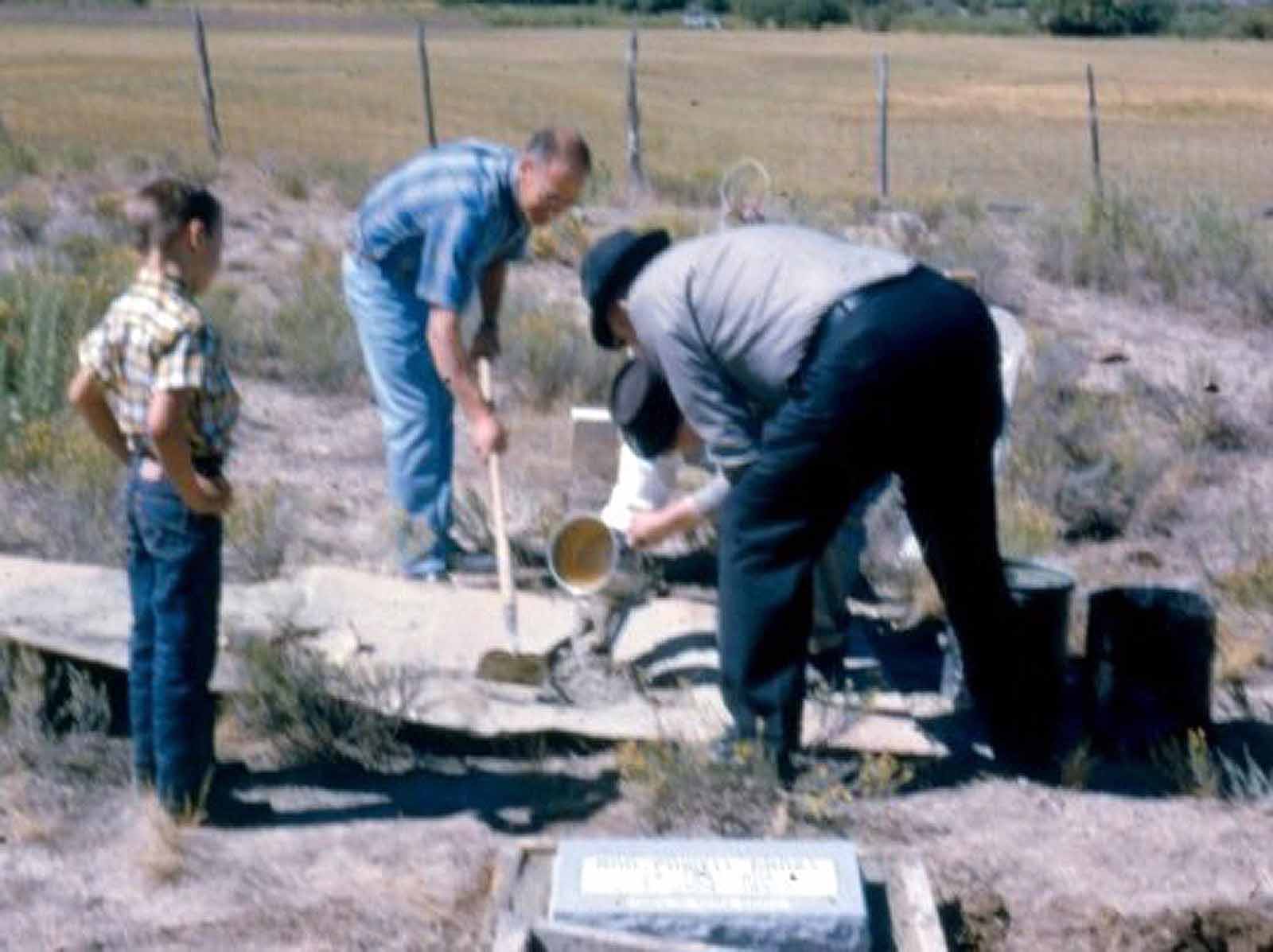
In the fall of 2005, while going through my deceased parent’s papers, I came
across a letter, written to my father in 2000. It was from an Edward Powell
of Hartlepool, England. Because my father was not living when the letter arrived,
it had been put in with his papers, and never answered. I took a chance, and
sent an answer, hoping that during the five years that had passed, Edward Powell
would still be living at the return address. I included my email address, and
a short time later received a message from Edward, who responded that he had
been searching for his ancestors, and though not a member of the LDS Church,
had used Familysearch.org to get information, and had found my father’s
name as having contributed information. His ancestsor, Mordecai Powell, was
a brother to William Powell, who was Ann Powell Danks father. Edward kindly
sent me a copy of a small book he wrote concerning his research on these lines,
entitled 'The Road From the Valleys' We have continued emailing sporadically,
referring to each other as 'Dear Cousin'
Ruth Blacker Waite
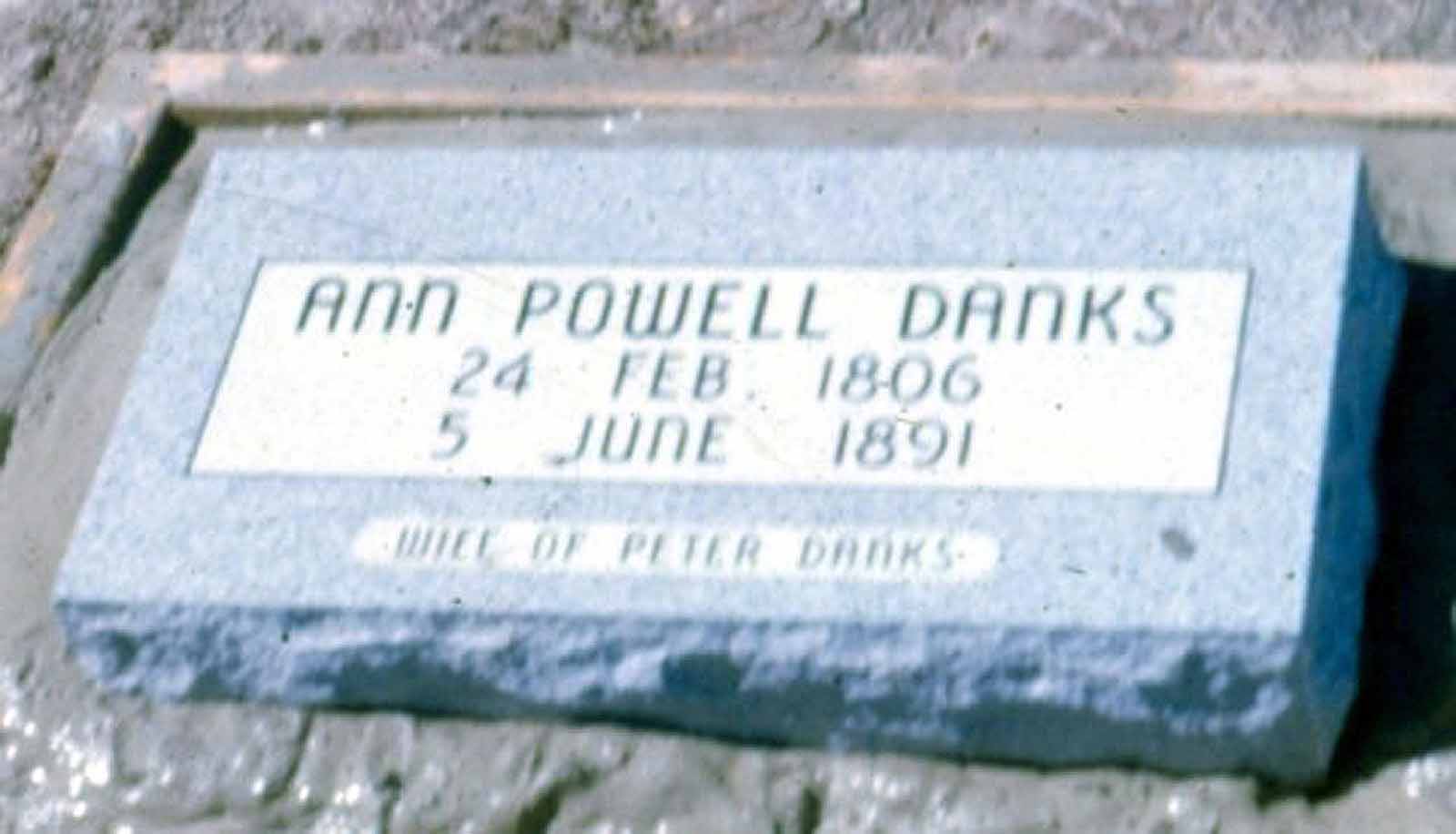
Family records tell us that the older Peter Danks with his wife, Ann Powell, first moved to Pennsylvania and that he passed away and was buried there. Mother Ann, eventually reached Almy, where she probably lived with some of her children in her older age. She was 85 when she passed away and was buried in the Almy cemetery at the side of her daughter, Mary Danks Loveday. Some of the members of the family organization will remember that in September of 1966, a reasonably good representation met in Evanston, Wyoming. We went as a group to place two headstones on graves in the Almy cemetery, one of which was to be at the head of the grave of Ann Powell Danks born 24 February 1806 and who died 5 June 1891. While the grave originally had a wooden marker and the mound was still sufficiently evident as to where the grave was, the marker had fallen over with age. There was no problem in identifying where the headstone should be placed; however, we contacted Lyman Brown, the sexton, who had a map of the lots in the cemetery and confirmed the spot.
Now returning to the ancestry of Isaac Loveday, let us review the family tree as shown on the Lowther-Lowden chart.
For several years we had been searching for confirmation of data on the Loveday lines. This data had previously been gathered from family and other local records, such as ward and branch records of Almy, Wyoming, and Pontypool Branch records of which we have already referred. Probably the single most helpful Loveday data was found in about 1937 or 1938 when we ran across an article in a large printed volume entitled "Progressive Men of the State of Wyoming" which was published in 1903 by A. W. Bowen & Co., Publishers. An account of Isaac Loveday was of special interest to us. For the purpose of identification, this article will be quoted in part only at this point in this story. The balance of the account will be more timely later. The account, undoubtedly, was a product of a personal interview and, while written in the second person, the substance had to originate from Isaac Loveday himself. Quoting:
"He was born in Wiltshire, England, September 15, 1821, and is a son of Solomon and Mary (Godin) Loveday, the former of whom was a son of Jonathan and Sarah Loveday and was a farmer by vocation. Isaac Loveday, naturally enough, was reared to agricultural pursuits, and his youthful days were so closely occupied by his duties on the home farm that little opportunity was afforded him to acquire an education; nevertheless, he attended the common school for a season or two and learned what little was absolutely necessary for him to know in carrying on the calling which was to be his life work. For some years he worked as a farm hand for his neighbors in England, and also passed a few years in Wales, engaged in the same capacity.
"- - - - -The marriage of Mr. Loveday took place in Wales on August 5, 1849, with Miss Mary Danks, a daughter of Peter and Anna (Powell) Danks, natives of Wales, and to this union there were born seven children, namely, Hiram, Marintha Althera, Kemuel, Fannie E., Thomas, who was born in Wales, February 25th 1859, also died in that country when nineteen years of age; Isaac, Sarah A., who was born in Wales October 25, 1865 and there died July 1, 1866. Mrs. Mary (Danks) Loveday was born in Wales in 1832 - - -."
As can be seen names of all their children were given and, in an instance or two, birth and death years of those who passed away. Where dates were missing in the above account, they were subsequently obtained from family records already at hand with various family members and/or also from church records.
One observation may be made at this point: Isaac listed one of his daughters, Marintha Althera to whom attention has already been drawn. This is the first instance we have found the name Merintha being used with Althera. There has been some questions among family members, but its use in the family records stems from her father. He did, however, used it with an 'a' instead of our conventional 'e'. This could have been an error on the part of the printer or it may be as the father would have wished it. The Afton ward L.D.S. records on an occasion or two, uses the two names, however, Grandma Blacker's name has had far wider use with Althera only.
This account of Isaac Loveday became very helpful in later research for he gave the names of both his parents - Solomon and Mary Godin, later found to have been Gooding - and his grandparents on the Loveday side, Jonathan and Sarah.
With this account at hand our next step for a well established family record was documentation . While family data is of utmost importance, it is often fraught with errors due to memory having been relied on, and so we were led to verify and, in instances, add to what data we had. Census records are often turned to, for that source is one of the few possibilities or finding a list of all members of the family in a single record. Grandpa Isaac was kind enough to leave two sets of parent's name - his fathers and grandfathers - so we naturally turned to the 1841 and the 1851 census records. English census records earlier than the 1841 census are of very little genealogical value, therefore we started with the 1841 record.
Census records are valuable for what they are but a census record, after all, is but a method of governments or any agency, has in getting a head count. There are other social reasons for taking a census, but they become secondary purposes. Information on census records is usually limited and certainly very much abbreviated. The name of the head of the household usually starts the list of names of people residing in the house and other names are added, usually in the order of age. The relationship of others in the house is given to the head of the house. In the census records to which is here being referred only the age is given - no birthdates are required. If a member of the family is not in the house that evening he is not counted. He or she will be counted in the house where he was at the time so, all in all, it can readily be seen that while a census record has its importance, it also has its shortcomings. Too, the census taker often becomes careless and can become very inefficient in his assignment. The one giving the information may be misunderstood and the wrong information is recorded. Oft times a child of the household gives the information to the census taker. One can go on and on as to the virtues of a census record as well as the weakness of such a record. While such a record is not acceptable as a record for documentation, it nevertheless, becomes a helpful record. It is not meant to be a record of final resort.
From the 1851 census we found a Solomon Loveday, but his wife in this instance was a Rachel whom we later found to be his second wife. We later found his first wife, Mary Gooding to have died in 1827 at the early age of 35. She had died in childbirth. Several children of both wives were listed in this census. The surname here was Loveday.
The researcher then secured a birth certificate for the youngest child, William, the purpose of which was to determine the exact parish in which the family was living. They found that the birth was in 1838 in the District of Marlborough in the County of Wiltshire. The informant was Solomon Loveday, father, living in Broad Town, in Broad Hinton. The researcher then wrote to Broad Hinton for a search of their christening records, but the Vicar found no entries of either Gooding or Loveday.
With the data from the 1851 census nor the data from the birth certificate providing no help so far as finding the family in a parish record, the researcher was then instructed to go to the 1841 census to an earlier record of the family for a possible clue.
The researcher then wrote back to us in a letter of December 20, 1946, and said,
"We obtained the 1841 census of Broad Hinton, Wilts., to confirm that Isaac Loveday belonged to the family shown in the 1851 census. He is shown there, aged 18, confirming his approximate birth year as 1822.
"We then wrote to the parish of Broad Hinton to obtain the christening entries of the children of Solomon Loveday and Mary. The Vicar wrote back to say that he had searched his registers: 1818-1840 but found no LOVEDAY surnames. He said there was a family by the name of Solomon and Mary Lowther with children christened in that period and asked whether the name could have been confused."
The little project of locating the Loveday family in a parish record was becoming quite disconcerting. We knew the family was there for the Census of both 1841 and 1851 said as much. Our finding the Lovedays was interestingly becoming a challenge. In consultation with the Genealogical Society we concluded to have the minister check at an earlier period of time - this time not for the children of Solomon Loveday, but for the christening of Solomon, himself, and if not Solomon Loveday, then for Solomon Lowther, which name the Vicar had given of a family in his parish records.
Remember, Grandpa Isaac Loveday, in the account in "Progressive Men of the State of Wyoming" had said his father and mother were Solomon and Mary and that his grandparents were Jonathan and Sarah. Note this reply from the Vicar in his search for Solomon:
"Baptized: 1792 Jan 8 Solomon son of Jonathan and Sarah Lowden.
Married: Solomon Lowder and Mary Godwin of this parish were married in this Church by Banns with consent of parents this 22 April 1813 in the presence of Mary Crook and Thomas Eatwell, Signatures shown by an "X".
"The Vicar states there seems to be considerable variation in spelling the names. Evidently neither part of the marriage was able to write his name so one can easily imagine how mistakes might arise".
Keep in mind the fact that in writing to the Vicar for the christening (baptism) of Solomon, it was for the surname LOWTHER so the above baptismal (christening) records reads, 1792 Jan 8 Solomon son of Jonathan (LOWTHER) and Sarah Lowden.
This entry gives Jonathan and Sarah as Solomon's parents, exactly as Grandpa Isaac Loveday said excepting the surname now is Lowther.
We felt, after receiving this report that we were in the process of getting on the right tract, but more evidence was still needed. At this point we wrote to the Vicar and this time asked him for the Lowther entries in his parish of the children of Solomon and Mary. Time was passing and the following information came to us from the Genealogical Society which was dated 5th January 1948:
"Note this family as compared with 1841 census: Isaac, aged 18 born 1822/23 Mary, aged 14 born 1827 George (Not included with this family, but could be first child)
"The next three children shown in the Census born after 1834 John, aged 6, born 1834 Hannah, aged 5, born 1835 William, aged 3, born 1837 are evidently children of the second wife Rachel Tuck Lowther (Loveday)."
The Genealogical Society, after appraising the whole of the situation wrote,
"We recommend that the name of Lowther be accepted as a legitimate name from which the name Loveday has come".
Further research was done and the names of the children of the previous generation were obtained - all with the surname of Lowther - but all the time we retained deep concern as to the accepting of the new surname. With this next generation with Jonathan and Sarah as the parents and their ten children, we appear to have come to an end with our Loveday-Lowther research. Theirs was the last generation by these names in the Broad Hinton parish. From whence the first came to this parish we are still searching.
After reaching the above conclusion with all its evidences, the matter remained on my mind and after 15 additional years I wrote to Frank Smith, at the time the Genealogical Society's superintendent of research. He was probably the Society's best qualified English researcher. I asked him to review the situation again and give his opinion. On the bottom of my letter to him dated 25 October 1963 he wrote:
"Regard spelling variations such as Loveday to Lowther:
"Until recent times there was no agreed way of spelling any given name or surname or place. Persons spelled it as: 1. They heard it 2. It was pronounced 3. They thought it should be spelled.
"Dialect played an important part in how a person heard the name. In Wiltshire and Somerset the population have a very broad and peculiar dialect and with my experience I can easily see how Loveday could be written Lowder. This is not a name change, but the rule that it be written as it was found in the original record.
"In Nottinghamshire where the surname Lowder or Lowther also occurs it may never be written as Loveday because the dialect is different.
"Understanding these problems is very difficult for those who are not native to these places.
"On the above basis the entries should be regarded as correct and should be shown on your pedigree charts that way for that particular individual. This does not mean you change the spelling for each other generation on the pedigree."
Frank Smith
Supt. of Research
It is hoped the reader and/or member of the family organization and any other who may be affected in any manner, will understand that there has been much concern relative to the Loveday-Lowder-Lowther name debacle and that the change has only been accepted after professional people have recognized and have recommended we accept such.
At this point let us now return to, at least mention, other branches of the ancestral family of which little or nothing has been written due, mainly, that there is but little to write. Of these such as the surname Bowditch, Sage, Naish and Nicholas, we wish to make comment.
In as much as a picture is worth a thousand words, so someone has said, please note below a family tree showing only the portions of the beginning of our family tree which reference is here being made:
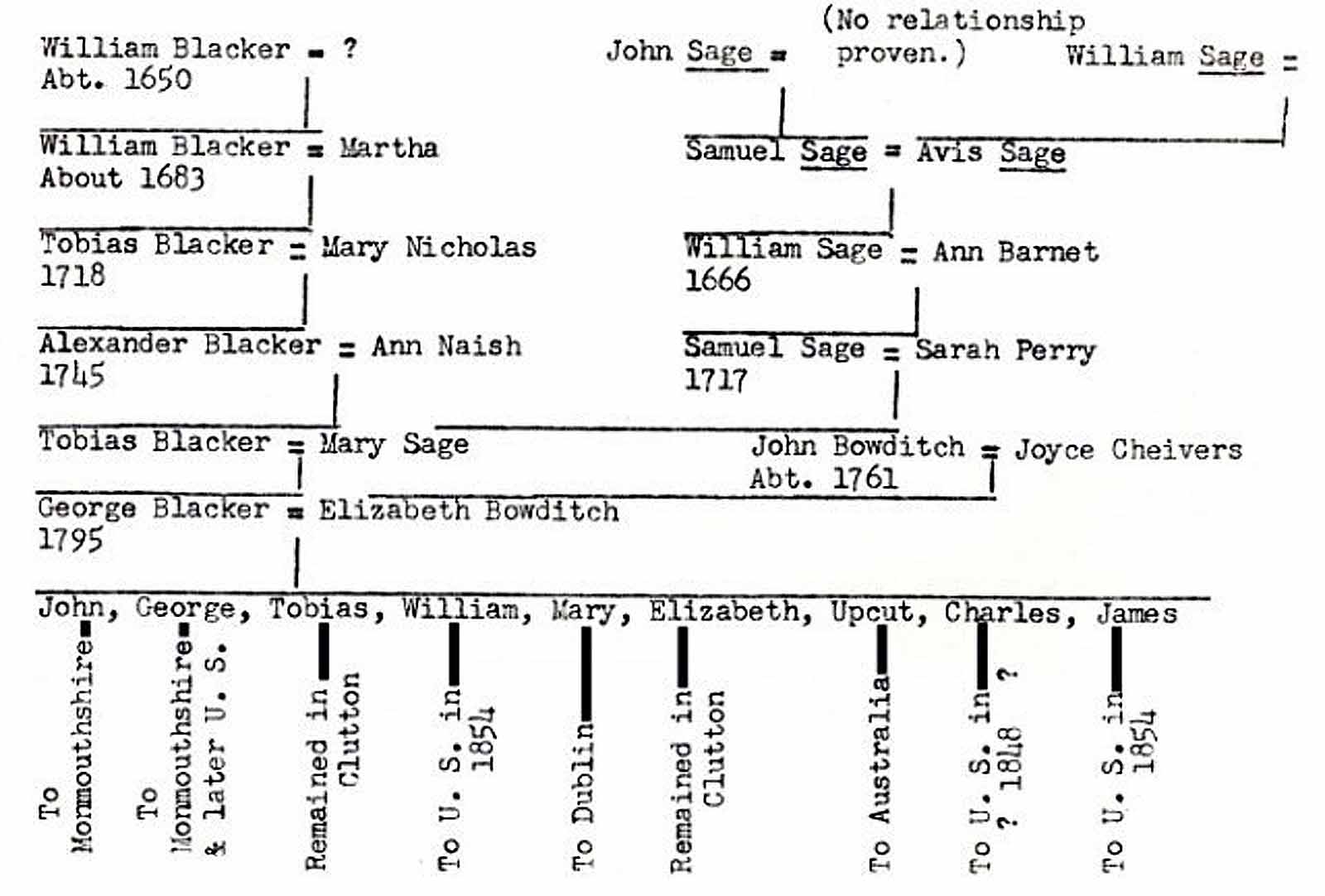
At the commencement of this story it was mentioned that, basically, the account was to follow the Blacker surname. While any surname on any pedigree contributes as much as any other name in the same generation to any of us, their descendants, it yet remains, space is limited as well as research has been more limited and so fewer details have been gathered. As an example, our George Blacker, a direct progenitor, married Elizabeth Bowditch, also a direct progenitor shown on the second generation from the bottom of the chart on the previous page. The 'law of genes' tells us she had as much to do with the transmission of inherent characteristics as did George, her husband. It is not from the fact that we feel she isn't so important to us of the family organization for she is but, as the excuse was stated, space and research - or the lack of it - leaves reason for another of the family to write a longer and more interesting story at another time and in another book about these other surnames.
Elizabeth Bowditch was born in Timsbury, less than three miles directly to the east of Clutton. While it was a parish at the time Elizabeth was a child, Timsbury had a population of 165 people. Her birth date and names of her parents were obtained from the parish record of that place.
Now, turning to Mary Sage, the mother of Elizabeth Bowditch's husband, and another g.,g.,g., grandmother: It was Mary who was left a widow with two very young children with her youngest not to be born for yet another four months following her taking husband, Tobias, to the Clutton cemetery late in September of 1799. She shared the care of her oldest little boy, George, with his grandparents, we are sure with reluctance in spite of necessity.
Mary was born at Cameley 3 miles southwest of Clutton. Cameley was a little town of 658 people during the time Mary was growing up, about half the size of Clutton, the town where her yet to be husband was growing up and where they were married. Mary's father and mother were Samuel Sage and Sarah Perry. Her father, likewise, was born in Cameley and it was there where the parents were married. Mother, Sarah Perry may have also been born in Cameley, however, neither her birth nor christening place have been proven.
Samuel's father, William Sage, likewise, was born in Cameley on the 6th of September 1666 and married Ann Barnet, Samuel's to-be mother. Their marriage date has not been found (This date has since been found as shown below. RMW), but their first child, Barnard Sage was christened in 1713 at Cameley. William appears to have been older than most men when their first child is born, for at the time of Barnard's birth his father was forty-seven. Two other children were born to the couple when the fourth child, the above Samuel, their last child, was born and christened on the 11th of February 1717. We must not nor have we overlooked the fact that William could have had children prior to the first of which we have a record, however, despite considerable research, none have been found. We are aware of such a possibility of him having older children in as much as their marriage date and place have not been located. It is entirely possible this family of four is but the last half of a larger posterity.
 In 2005, while viewing the film of Cameley Parish marriages I located this entry
for the marriage of William Sage and Ann Barnett on 28 July 1709.
In 2005, while viewing the film of Cameley Parish marriages I located this entry
for the marriage of William Sage and Ann Barnett on 28 July 1709.
The entry reads, 'William Sage and Ann Barnett was married in Cameley church July the 28 whose banns being three times published' Ruth Blacker Waite
 Barnard Sage ye son of William and Ann Sage was baptized Aug. 20-1713
Barnard Sage ye son of William and Ann Sage was baptized Aug. 20-1713
Back another generation from William Sage is his father, Samuel, who married Avis Sage. The underlining of the name Sage on the chart on the previous page was purposely done to indicate the joining of two Sage names was according to the records. Presumably Samuel's parents' home was in Cameley for he, with all his eight brothers and sisters - 9 children - were christened in that parish.
No evidence has been found to lead us to believe husband, Samuel, and wife, Avis Sage were related, but neither has evidence been found to indicate they weren't as the chart indicates, Samuel's father was named John and Avis' father's name was William.
There has come to our attention no indication of the type work these families did but, from the fact that the locality was very much rural may lead one to suspect agriculture.
The other surnames on the chart or family tree, if one so desires to term it such, have been searched for additional family data but none has come to our attention. The Nicholas, the Naish, the Cheivers, the Perry and Barnet names fall into this category. Even the surrounding parishes to the ones in which our families have been searched have, likewise, been searched. From these points, even the professional researchers do not know where to turn. Many records have been lost or destroyed by any number of means. Perhaps someday other records will be located.
As we conclude this chapter we are also nearing the end of the Blacker story in England. George Blacker's and Elizabeth Bowditch's children were purposely included on the family chart shown above. Considerably earlier these same children were shown on a chart. The eldest son, John, became the subject of our family review when he and his wife, Maria Gould, took their little family from Clutton to Monmouthshire in about 1847. The story to this point has been confined to his family and his offspring's families.
Many of that family moved from Monmouthshire to Glamorganshire where we have left two families, in particular, the Edward Blacker and Althera Loveday family and the Isaac Loveday and Mary Danks family who, soon after our discussing them, will immigrate to America. For the present we shall bid them adieu in our story and now continue on with five other children, - interestingly all boys - of George Blacker and Elizabeth Bowditch family.
This family, during the growing-up years of the children were all residents of Clutton. Undoubtedly due to the economic conditions of the time there had been much 'dreaming' of better days. The rural areas in England such as Somersetshire during these years of the 1820s and 1830s and certainly the 1840s, were experiencing the depopulation of small towns and villages. People were migrating to factory centers which were mainly in the Midlands and, particularly to the north of England where wages hardly kept body and soul alive, but were still better than agricultural wages in the rural areas.
England's population was increasing at a rapid rate. Their census figures indicate that in the 1801 Census there was a population of nine million. Ten years later in 1811, ten million, twelve million in 1821, thirteen and a half million 1831, sixteen million in 1841 and eighteen million in 1851, the period which we are considering. So England was fast becoming a country of large towns, mostly in the north. There were few incentives left for people in the counties of south England who found it difficult to see much future in moving to the now-becoming industrialized cities to the north. At this same time the opportunities of the great westward movement were beckoning in the united States and large numbers of English families were leaving England for, not only the United States, but for Canada, New Zealand, South Africa, and Australia. It was estimated that more than eight million emigrants left England during these three or four decades which we are reviewing.
There can be no question but that word of the prospects of owning their own home, of owning land or whatnot was getting back to England from friends and neighbors who had become sufficiently daring to take the step of emigrating. Not that they found ease and luxury, but rather that the prospects for the future were certainly brighter than the prospects with which they had been living in their homeland.
We have previously wondered about John and Maria with their little family going north into Monmouthshire. The urge to find something different, actually the need to find something different, became pressing. This one family, with John's daring to make the break, undoubtedly aroused curiosity among his brothers. Two to three years later, young, daring George Blacker of Clutton, joined a boat company with his new wife, Sarah Matthews, to set sail for Australia one day following their marriage on the 23rd of June 1858. If he was related, it was distantly, for one hundred and thirty years later we haven't proven a definite relationship, however, we are sure it was there.
John's brothers, now all but one, James, were married and waiting to make the move. It may have been that they actually dared each other, but when the new year of 1854 came around, they were yet waiting, but not for much longer.